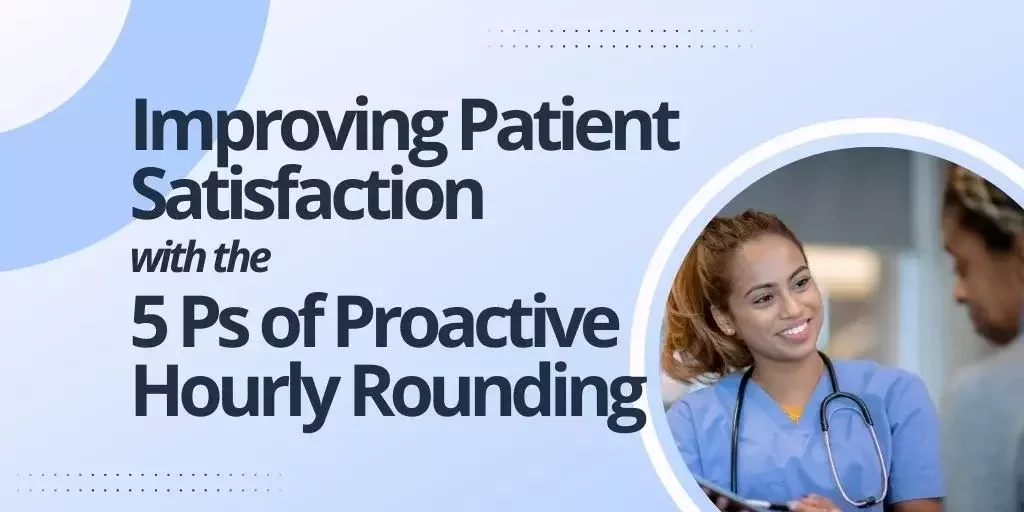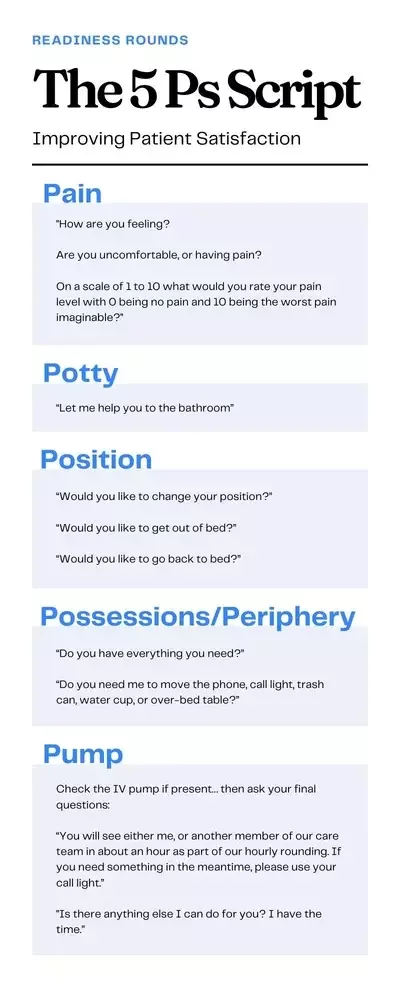
1. Defined: What is “The 5 Ps of Proactive Hourly Rounding”?
2. Why is the 5 Ps of Hourly Rounding Important?
Because it signals to the patient that their care is top priority.
Because it provides numerous benefits for nurses and patient alike:
- Fall Reduction: Over 50% –Numerous studies have shown that ensuring patients have access to their personal items, are comfortable and have their bathroom needs met reduces fall rates by more than 50%.
- Pressure Ulcer Reduction: 10% – Many hospitals implementing this approach have shown a decline in skin breakdowns and pressure ulcers in excess of 10%.
- Call Light Reduction: 40% – Call light usage can be reduced over 40% with effective deployment. The improvement in patient satisfaction is significant but perhaps the biggest benefit with this reduction is the decrease in walking time for nursing staff and the improvement in job satisfaction due to not being constantly interrupted.
- Overall Patient Satisfaction typically improves by over 10%.
First some thoughts about Scripts. Many in nursing feel a script sounds too automated and restricting. You are almost certainly thinking scripts won't work.
Scripts serve two important functions:
1) You have a standard to which you can hold staff accountable
2) You have a structure in which to train new staff.
Making a good effort will almost certainly improve results however, without scripts, the probability of sustaining over time is significantly reduced. (Have you been to a stage production where the script is left to the actors to make up?)
The 5 Ps of hourly rounding are as follows:
#1. Pain
Purpose: The goal is to ensure the patient's comfort and alleviate any discomfort or distress.

#2. Potty
Purpose: Along with comfort routine assistance is a proven satisfier and reduces the likelihood of falls.
Script: “Let me help you to the bathroom.”
Avoid asking for permission e.g. Do you need to use the bathroom. Many patients feel like they are being a nuisance and wasting your time. Instead, offer to assist the patient with toileting needs. Actively addressing toileting needs during hourly patient rounds results in the patient trusting that nursing staff will anticipate their needs and be there to assist them regularly. This in turn reduces call light usage and results in fewer workflow interruptions.
#3. Position
Purpose: Proper patient positioning is essential for maintaining comfort, preventing complications (such as pressure ulcers).
Script: “Would you like to change your position?”
“Would you like to get out of bed?”
“Would you like to go back to bed?"
Assist the patient with turning or repositioning to prevent pressure ulcers or skin breakdown and to increase comfort. This may include assisting the patient out of bed (OOB), or returning the patient to bed. Offer additional pillows or blankets.
#4. Possessions & Periphery
Purpose: To ensure that the patient has easy access to possessions and that surroundings are safe, clean, and conducive to their well-being.
Script: “Do you have everything you need?”
“Do you need me to move the phone, call light, trash can, water cup, or over-bed table?”
Ensure patient possessions are within reach (e.g. call light, cell phone, water pitcher, tissues, trash can, glasses), and clear the room of any clutter, trash, and potential fall hazards such as cords, linens, etc.
#5. Pump
Lastly, Before Leaving the Room
Script: “You will see either me, or another member of our care team in about an hour as part of our hourly rounding. If you need something in the meantime, please use your call light.”
"Is there anything else I can do for you? I have the time.”
- Patients need to know when they will see you again.
- Check that communication board is current.
The 5 Ps is just 1 of the 17 proven ways to improve patient satisfaction. See all 17 strategies in our free PDF ebook here.
4. Obstacles to Successfully Implementing a
5 Ps Hourly Rounding Process:
Despite all the effort put into implementing, most hospitals struggle to execute hourly rounding well and consistently.
Before we look at how to best implement, let’s look at some of the obstacles experienced when attempting to execute the 5 Ps properly.
Obvious Obstacles to the 5 Ps:
- Lack of Nursing Leadership Commitment
Without senior nursing being “all in” these efforts will not be sustainable. - Lack of Commitment to Structure
Without an agreed standardized structure efforts are likely to falter. - Lack of Staff Training
Initial classroom training session for existing staff needed.
Ongoing on the job coaching built in.
Significant part of all nursing and patient care technicians orientation. - Lack of Communication Boards in Place
Effective communication boards essential - The Inability to Quantify or Analyze Results
Staff coaching results
Call light trends
Fall trends
Hidden Obstacles to the 5 Ps:
- The Culture
Hourly rounding is a culture shift. Be aware that it will not become a part of your hospital culture in 60 days. This requires sustained focus and attention to have an impact. - The Script
Train, educate and insist on scripting.
You may be thinking "we cannot go with scripts." If you want to be able to sustain this approach long term, you will see best results with a script.
Scripts serve two important functions:
1) You have a standard to which you can hold staff accountable
2) You have a basis on which to train new staff
INSIST ON SCRIPTS. - The Purpose
Make it about doing the right thing for patient safety. AS INDEED IT IS. Don't ignore patient satisfaction as the goals but stay firmly focussed on safety outcomes. - The Focus
Focus on reducing falls and skin breakdowns and most nursing staff will become very engaged. - The Communication Board
Ensure you have daily patient rounds that include getting patient feedback and evaluating effective use of the communication board.
The 5 Ps of hourly rounding, while historically difficult to implement successfully, is fully doable with a sustainable structure in place and buy-in from the culture at large. Your patients deserve the best care possible. Your safety outcomes and HCAHPS scores will improve.
Readiness Rounds walks our clients through this process and a wide variety of other improvement strategies. We would be honored to be a partner in your patient satisfaction improvement journey. We’re here to chat anytime.
Continue Learning
At Readiness Rounds, we’ve developed a proven approach to improving Patient Satisfaction and Experience. We call it the 9 Approaches. Watch the free video series here.
Sources
Here are a few sources that demonstrate the effectiveness of hourly rounding on patients in acute care hospitals:
- Halm, M. A., & Afifi, S. (2015). Hourly rounding and patient falls: What factors boost success?. American Journal of Critical Care, 24(4), 278-285. doi:10.4037/ajcc2015561
- Halm, M. A. (2009). Hourly rounds: What does the evidence indicate?. American Journal of Critical Care, 18(6), 581-584. doi:10.4037/ajcc2009999
- Meade, C. M., Bursell, A. L., & Ketelsen, L. (2006). Effects of nursing rounds: On patients' call light use, satisfaction, and safety. American Journal of Nursing, 106(9), 58-70. doi:10.1097/00000446-200609000-00026
- Tschannen, D., Rothenberger, L., & Sona, C. (2012). Exploring evidence-based nursing practice: Hourly rounding. Nursing Management, 43(4), 50-54. doi:10.1097/01.numa.0000414320.74103.03
- Meade, C. M., & Bursell, A. L. (2006). Recognizing and responding to patient distress: The impact of nurses' supportive behaviors. Journal of Advanced Nursing, 56(5), 520-528. doi:10.1111/j.1365-2648.2006.04045.x
These sources provide evidence and research findings on the positive impact of hourly rounding on various aspects such as patient falls, call light use, patient satisfaction, safety, and nurses' supportive behaviors
Here are a few sources that demonstrate the effectiveness of hourly rounding on patients in acute care hospitals:
- Halm, M. A., & Afifi, S. (2015). Hourly rounding and patient falls: What factors boost success?. American Journal of Critical Care, 24(4), 278-285. doi:10.4037/ajcc2015561
- Halm, M. A. (2009). Hourly rounds: What does the evidence indicate?. American Journal of Critical Care, 18(6), 581-584. doi:10.4037/ajcc2009999
- Meade, C. M., Bursell, A. L., & Ketelsen, L. (2006). Effects of nursing rounds: On patients' call light use, satisfaction, and safety. American Journal of Nursing, 106(9), 58-70. doi:10.1097/00000446-200609000-00026
- Tschannen, D., Rothenberger, L., & Sona, C. (2012). Exploring evidence-based nursing practice: Hourly rounding. Nursing Management, 43(4), 50-54. doi:10.1097/01.numa.0000414320.74103.03
- Meade, C. M., & Bursell, A. L. (2006). Recognizing and responding to patient distress: The impact of nurses' supportive behaviors. Journal of Advanced Nursing, 56(5), 520-528. doi:10.1111/j.1365-2648.2006.04045.x
These sources provide evidence and research findings on the positive impact of hourly rounding on various aspects such as patient falls, call light use, patient satisfaction, safety, and nurses' supportive behaviors
